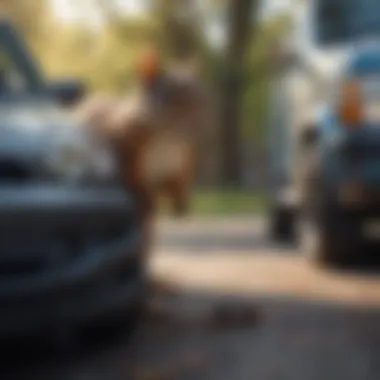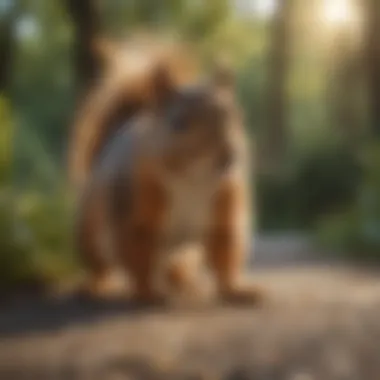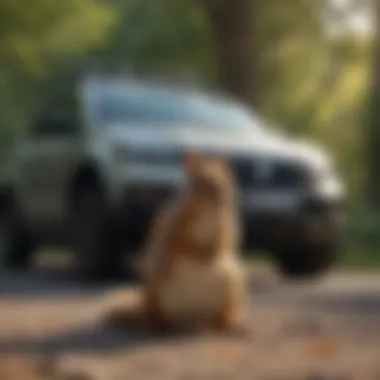Squirrel Repellent for Vehicles: Understanding and Control


Intro
Squirrels, though often perceived as charming woodland creatures, can pose significant challenges for vehicle owners. Their penchant for chewing through wires, insulation, and rubber components can result in costly repairs and safety hazards. Understanding the behaviors and biology of these rodents is essential for effective prevention and control. This article provides valuable insights into how to safeguard your vehicle from squirrel-related damage, the various prevention strategies that can be employed, and outlines control methods to address infestations if they occur.
Understanding the Pest
Identification
Squirrels belong to the family Sciuridae and can be commonly found in urban and suburban areas. The gray squirrel is among the most frequently encountered species in North America. Recognizable for its bushy tail and gray fur, this rodent typically measures between 16 to 20 inches, not including its tail.
Important characteristics to look for include:
- Coloration: Gray squirrels have a gray coat with a white underbelly.
- Size: Adults weigh around 1.5 to 2 pounds.
- Behavior: They are diurnal, meaning they are active during the day, often seen scampering around trees and ground.
Life Cycle
Understanding the life cycle of squirrels can aid in developing effective management strategies. Typically, these animals breed twice a year, in late winter and mid-summer. After a gestation period of about 44 days, female squirrels give birth to litters ranging from two to six young.
The young remain in the nest for approximately ten weeks, during which they learn essential survival skills. Familiarizing oneself with their life cycle, particularly during breeding seasons, can help in anticipating and mitigating potential vehicle damage.
Pest Prevention Strategies
Environment Modification
Adapting the surroundings of your vehicle can help deter squirrels from taking an interest in it. Some effective modifications include:
- Remove food sources: Ensure that there are no food remnants or bird feed that may attract squirrels to the area.
- Maintain cleanliness: Keep the surroundings clear of debris and overgrown vegetation that can serve as nesting sites.
Physical Barriers
Creating physical obstacles can significantly reduce the likelihood of squirrels gnawing on your vehicle:
- Use vehicle covers: Invest in high-quality tarps or covers designed to fit securely over your car.
- Park strategically: Avoid parking too close to trees or shrubs where squirrels may easily access your vehicle.
Control Methods
Chemical Control
While preventing squirrel activity is ideal, control methods may be necessary if an infestation occurs. Chemical repellents designed specifically for squirrels can be effective:
- Natural repellents: Products containing capsaicin or essential oils (like peppermint) can deter squirrels.
- Commercial sprays: There are several commercial repellents available that can be applied directly onto your vehicle.
Biological Control
For a more eco-friendly approach, consider biological control methods:
- Predator scents: Introducing scents from natural predators may create a deterrent for squirrels in the area.
- Live traps: These can help capture squirrels humanely, allowing for relocation. Be aware of local regulations regarding this practice.
"Effective prevention and management of squirrels requires understanding their behavior and adapting conditions to make your vehicle less appealing."
Prelims to Squirrel Infestation in Vehicles
Understanding the impact of squirrels on vehicles is essential for car owners. Squirrels can cause significant damage, particularly when they take up residence in or around vehicles. Their behavior is often driven by the search for food and nesting sites, which can lead to unwanted infestations. This article provides a detailed exploration of this issue, outlining prevention methods and control measures that are practical and effective.
The Problem of Squirrels and Vehicles
Squirrels are resourceful creatures that adapt well to urban environments. They often perceive vehicles as suitable shelter. This can pose a serious problem for car owners. When squirrels inhabit vehicles, they may chew on wiring, insulation, and other vital components. This behavior occurs especially during colder months, when they seek warmth and a safe environment for nesting.
In addition, squirrel activity is not limited to personal vehicles. Commercial fleets can also face similar issues. The damage caused by squirrels can result in costly repairs and downtime, affecting business operations. Awareness of the problem is the first step towards prevention. Understanding when and why squirrels target vehicles enables owners to take proactive measures to mitigate the risk.


Impact of Squirrel Damage on Vehicles
The impact of squirrel damage can vary widely, depending on the level of infestation and the specific areas affected.
- Electrical Systems: Squirrels are notorious for chewing through wires. This can lead to electrical failures, resulting in major repair costs.
- Hoses and Belts: Chewing can also damage hoses and belts. This may cause leaks and lead to engine overheating, which is dangerous for the vehicle.
- Air Intake Systems: Nesting materials can obstruct air intake systems. This hampers engine performance and efficiency.
"A small squirrel problem can quickly escalate, leading to extensive damage and expensive repairs."
The cost is not just financial; it can also impact safety. Damaged vehicles pose hazards on the road, potentially putting other drivers at risk. Vehicle owners should frequently inspect their cars for signs of squirrel activity. Early detection is critical in preventing further damage and maintaining vehicle integrity.
Understanding Squirrel Biology and Behavior
Understanding squirrel biology and behavior is fundamental in addressing the issue of vehicle infestations. This knowledge equips vehicle owners with strategic ways to deter these creatures before they cause damage. Squirrels are intelligent and adaptable, traits that often facilitate their intrusion into vehicles. Recognizing their behaviors helps in prevention and control. By learning about their patterns of activity, habits, and types can assist in creating a hostile environment from squirrels.
Additionally, comprehending their nesting behaviors and seasonal activities enables effective planning for vehicle protection, especially during vulnerable periods.
Species of Concern: Common Squirrel Types
Several squirrel species pose a threat to vehicles, particularly in urban and suburban areas. In North America, the most commonly encountered types include the Eastern Gray Squirrel, Fox Squirrel, and the Ground Squirrel.
- Eastern Gray Squirrel: These are highly adaptable and often inhabit parks and residential areas. They tend to build nests in trees but can take shelter in car engines.
- Fox Squirrel: Larger than the Eastern Gray, they are more solitary and can be seen foraging in open spaces. Their burrowing instincts can lead them to vehicles.
- Ground Squirrel: Though often found in rural settings, they can invade urban areas in search of food, posing a different challenge for vehicle owners.
Each of these species has unique behaviors that make them prone to entering vehicles. Hence, recognizing these types can aid in identifying potential risks and taking preventive measures.
Squirrels' Nesting Habits and Seasonal Patterns
Squirrels have specific nesting habits that influence when they seek shelter, including vehicles. They prefer to build nests in trees or sheltered areas, but during the breeding seasons, which occur in late winter and midsummer, they may venture and invade less secure spaces.
- Nesting Behavior: Squirrels typically create nests using leaves, twigs, and even shred of materials that they find. A vehicle's engine compartment offers warmth and relative security, making it an attractive nesting site.
- Seasonal Patterns: Understanding their seasonal movements is critical. In fall, they gather food and seek warmth, leading to an increased risk of vehicle entry. In spring, mothers look for safe places to give birth and raise their young, increasing the likelihood of them nesting within vehicles.
In summary, awareness of squirrel biology and behavior allows vehicle owners to anticipate and deter squirrel intrusions effectively. Knowledge empowers individuals to take appropriate actions tailored to the habits of their local squirrel populations. It is important for maintaining vehicle integrity and prolonging life.
Identifying Squirrel Damage in Vehicles
Understanding how to identify squirrel damage in vehicles is critical for owners. Early detection can prevent extensive damage and save you from costly repairs. This section focuses on common signs of squirrel activity and guidance on how to assess the damage that might be inflicted on your vehicle.
Signs of Squirrel Activity
Squirrels can be quite subtle, but their presence often leaves behind distinct indicators. Look for the following signs:
- Chewed Wires and Cables: Squirrels are notorious for gnawing on wiring as it aids in sharpening their ever-growing teeth. Damaged wires can lead to electrical issues, which may not present immediate symptoms.
- Nesting Materials: Keep an eye out for debris such as leaves, twigs, and grass, which can often be found near your vehicle if a squirrel has taken up residence.
- Tracks or Paw Prints: If your car is parked in an area where squirrels are common, you may notice small tracks around your tires or body. This can be a telltale sign of nearby activity.
- Droppings: Squirrel droppings can be found near or inside your vehicle. These are usually small, dark pellets and can help confirm the presence of these rodents.
- Noises: Listen for unusual sounds coming from under the hood or inside the vehicle, especially during dawn or dusk when squirrels are most active. Scratching, scurrying, or chattering noises may indicate a squirrel is nesting or moving around.
Recognizing these signs early can make a significant difference in addressing a potential infestation.
Assessing Vehicle Damage
Once indicators of squirrel activity are detected, the next step is to assess any damage. Here is a methodical approach to evaluate your vehicle’s condition:
- Visual Inspection: Start by lifting the hood and looking for signs of chewing or gnaw marks on various components, particularly the wiring harness.
- Check Electrical Systems: Test electrical components like lights and radio to ensure nothing has been damaged. A sudden failure in lighting or other systems could signal wire tampering.
- Inspect Under the Vehicle: Look for nests or droppings in the undercarriage area. This indicates a place where squirrels might have nested or sought shelter.
- Document the Condition: Take pictures of damaged areas. This can be helpful for consultations with mechanics or pest control professionals.
- Consult Professionals: If extensive damage is suspected, it may be wise to seek the help of a mechanic. They can provide a thorough examination and recommend repairs needed to restore your vehicle’s integrity.
Common Repellent Strategies for Squirrel Control
Squirrel management is crucial for vehicle preservation. Understanding the various repellent strategies allows vehicle owners to choose appropriate methods that align with their values and practices. The main objective is to create an environment unwelcoming to squirrels while minimizing potential vehicle damage.
Chemical Repellents and Their Effectiveness
Chemical repellents come in various formulations, often designed to deter squirrels with strong scents or taste aversion. Some common chemical repellents include predator urine, certain essential oils, and commercial sprays specifically targeting rodents.
When it comes to effectiveness, the results can be mixed. Some vehicle owners report success using commercial products that emit smells unpleasant to squirrels. However, factors such as the local squirrel population and environmental conditions may influence overall efficacy. Regular application is key, as most chemical repellents lose their effectiveness over time, especially after rain or heavy environmental exposure.


"The best strategy using chemical repellents is to rotate different products to prevent squirrels from adapting to a single type."
Natural and Eco-Friendly Repellent Options
Natural or eco-friendly deterrents are increasingly appealing to vehicle owners, driven by health and environmental concerns. Options such as peppermint oil, garlic spray, and vinegar are popular choices. These substances generally pose little risk to humans and pets, making them attractive alternatives to synthetic chemicals.
For instance, peppermint oil can be diluted in water and sprayed around parked vehicles, establishing a barrier that squirrels find less inviting. Garlic and vinegar have similar repellent properties, but they may require more frequent application due to their natural volatility.
Additionally, the inclusion of household items like dried red pepper flakes or cayenne pepper in specific areas may help deter squirrels. They tend to avoid strong aromas and unpleasant tastes, which can effectively create a protective perimeter around the vehicle.
Technological Solutions for Squirrel Deterrence
Technological solutions play a vital role in addressing the squirrel problem in vehicles. With the increasing number of vehicles, the need for effective deterrents has grown. These solutions combine innovation with practicality, offering diverse tools and techniques to manage squirrel activity effectively. They enhance the overall strategy for vehicle protection, providing options beyond traditional methods.
One major advantage of these technological solutions is their ability to target specific issues related to squirrel behavior. By employing devices that disrupt the sensory perception of squirrels, vehicle owners can create an unwelcoming environment. Furthermore, monitoring systems enable proactive pest management, allowing individuals to track squirrel activity in real time.
Moreover, the integration of technology can lead to more eco-friendly alternatives to harmful chemicals. Many modern systems are designed to minimize ecological impact while ensuring vehicle safety. These solutions also offer convenience, requiring less frequent manual intervention while maintaining efficiency.
Ultrasonic Repellent Devices: An Overview
Ultrasonic repellent devices have gained popularity as a non-invasive method for deterring squirrels. These devices emit high-frequency sound waves that are inaudible to humans but irritating to rodents. The sounds create a disorienting and uncomfortable environment for squirrels, potentially encouraging them to seek shelter elsewhere.
The implementation of ultrasonic devices is straightforward. They can be placed within or around the vehicle, often utilizing solar power or batteries. Users appreciate their low maintenance and effectiveness. However, it's important to note that the effectiveness of these devices can vary based on environmental factors and specific squirrel populations.
Some potential limitations include:
- Range of effectiveness: Ultrasound may not penetrate certain materials or surfaces.
- Adaptation: Squirrels may become accustomed to persistent noise over time.
Despite these setbacks, gadget enthusiasts find value in ultrasonic repellent technology for its ease of use and integration.
Monitoring Systems for Squirrel Activity
Monitoring systems represent another technological advancement in managing squirrel interference. These systems often incorporate motion sensors and cameras, enabling vehicle owners to receive alerts regarding potential squirrel activity.
These systems facilitate proactive measures, allowing timely intervention before significant damage occurs.
Key features of monitoring systems typically include:
- Real-time alerts: Notifications sent to users about squirrel presence.
- Video recording: Capture footage of any squirrel interactions with vehicles.
- Remote access: Users can monitor activity from their smartphones or computers.
The primary goal of monitoring systems is to provide intelligence on any squirrel incursions. By understanding patterns of squirrel behavior, users can effectively tailor their deterrent strategies. This aspect of technological solutions emphasizes the importance of informed decision-making.
In summary, technological advancements such as ultrasonic devices and monitoring systems offer innovative avenues for managing squirrel issues in vehicles. As vehicle protection continues to evolve, these solutions should be considered integral components in a holistic pest management strategy.
Preventive Measures for Vehicle Protection
Preventive measures play a critical role in safeguarding vehicles from squirrel infestations. Understanding these strategies not only minimizes damage but also reduces the need for costly repairs. A proactive approach allows vehicle owners to maintain their assets and avoid disruptions caused by wildlife interference. When it comes to prevention, awareness of squirrel behaviors and tendencies is essential. By recognizing what attracts squirrels to vehicles, owners can implement specific tactics to deter them effectively.
Parking Strategies to Deter Squirrels
Selecting the right parking location is a fundamental step in preventing squirrel access to vehicles. Here are some effective strategies to consider:
- Avoiding Dense Vegetation: Squirrels thrive in areas with abundant trees and shrubs. Parking away from such environments decreases the likelihood of squirrels making nests in your car or using it as a launching pad for their activities.
- Utilizing Garages or Secure Spaces: Whenever possible, park in a closed garage or a well-secured area. This provides physical barriers that prevent squirrels from accessing the vehicle entirely.
- Choosing Open Spaces: Opt for open parking areas that lack cover from nearby trees. Parking in well-lit, exposed sections can discourage squirrels from approaching.
- Regularly Change Parking Locations: If feasible, vary where you park. This strategy disrupts any patterns that squirrels develop around specific vehicles.
Regular Maintenance and Inspections
Ongoing vehicle maintenance and inspections are critical to detecting and addressing potential issues related to squirrel damage. It is wise to incorporate a routine check-up of both the exterior and the engine compartment:
- Frequent Inspections: Regularly inspect the area under the hood and around the perimeter of the vehicle for any signs of squirrel activity. Look for chew marks or nesting materials.
- Engine Compartment Checks: Squirrels can crawl into engine compartments and create nests or chew on wires. Ensure that engine hoses and wiring are intact, particularly after periods of inactivity.
- Cleaning and Removing Debris: Keep the vehicle clean and free of food remnants or organic materials. Squirrels are attracted to clutter, so maintaining a tidy vehicle reduces the chances of attracting rodents.


"A little prevention goes a long way in protecting your vehicle from squirrels. Regular maintenance is not just about functionality; it's about safeguarding against pests too."
Implementing these preventive measures offers significant benefits, including long-term cost savings and maintaining the vehicle's resale value. By understanding attractions for squirrels and combining effective parking strategies with diligent maintenance, vehicle owners can successfully safeguard their cars against these persistent rodents.
Community and Professional Pest Management
Community and professional pest management plays a critical role in handling squirrel infestations in vehicles. Engaging these resources not only enhances individual efforts but also fosters a collective approach to the issue. The importance of this topic cannot be overstated; squirrels are adaptable and persistent, requiring a coordinated strategy for effective control.
In urban and suburban communities, awareness of wildlife interactions is essential. Squirrels can cause significant damage to vehicles, often leading to costly repairs. By collaborating with local organizations, residents can work together to address the problem. This can include initiatives to educate communities about deterrent methods or promoting safe practices for parking and storage of vehicles.
Moreover, professional pest management services bring a level of expertise that can make a significant difference. These specialists have a comprehensive understanding of squirrel behavior and the best practices for mitigation. Their involvement comes with several benefits:
- Expert Evaluation: Professionals can assess the extent of the problem, identifying vulnerabilities that the average car owner might overlook.
- Effective Solutions: Trained experts often have access to resources and products not available to the general public, providing methods that are more effective in repelling squirrels.
- Long-term Strategies: They can offer sustainable solutions, looking at not only immediate control measures but also long-term prevention techniques.
It is also important to consider the broader environmental impact. Professionals can help implement strategies that protect both vehicles and the local ecosystem. Reducing problems caused by squirrels is also beneficial for community health and safety, as fewer wildlife interactions lead to a lower chance of disease transmission.
Engaging Community Resources for Pest Control
When looking at community resources, it is worth exploring local wildlife councils, neighborhood associations, and even social media groups. These platforms can provide valuable information and support for residents facing squirrel challenges. Communities can organize workshops or informational sessions focusing on effective squirrel control. Sharing experiences and resources within a community can strengthen individual efforts.
Volunteer groups may also assist in monitoring local squirrel populations and conducting surveys to understand better the areas most affected. This data can be valuable for creating targeted interventions. Encouraging open dialogues about the importance of this control measures leads to a more informed public, ultimately benefiting all.
Engaging with community resources is not only about gathering information. It also enables citizens to advocate for policies that promote wildlife control responsibly. Increased awareness about the impact of squirrel infestations on vehicles may prompt municipalities to address the issues more systematically.
Collaborating with Pest Control Specialists
Collaboration with professional pest control specialists offers a more structured approach to managing squirrel problems. Finding a reliable pest control company is essential. This service should ideally have a track record of treating wildlife issues uniquely and effectively.
There are several factors to consider when collaborating with professionals:
- Certifications and Licenses: Ensuring that specialists are certified and licensed guarantees a level of trust and skill in handling pest control.
- Experience with Squirrels: Not all pest control services are equal. Some may focus solely on insects or larger pests. Finding a team experienced with rodent problems, specifically squirrels, is crucial.
- Customized Approach: Each situation is different. A specialized service should create a tailored plan based on individual needs, focusing on both immediate relief and ongoing prevention.
Professionals can deploy a mix of traditional repellents and eco-friendly options, depending on a homeowner's preferences. They may also offer follow-up services to assess the effectiveness of the control measures implemented. Investing in professional help not only protects the vehicle from immediate damage but can also save money in the long run by preventing future infestations.
In summary, engaging with community resources and collaborating with pest control specialists enhances the ability to manage squirrel infestations effectively. By sharing knowledge, supporting each other, and utilizing professional expertise, homeowners can reduce the risks and impacts associated with squirrel activity in vehicles.
The End and Best Practices
In the discussion around squirrel repellent for vehicles, concluding thoughts help consolidate the information shared. Understanding the multifaceted nature of squirrel management is crucial. It is not merely about applying repellents; it's about adopting a comprehensive approach that encompasses prevention, detection, and timely intervention.
Effective squirrel repellent strategies are critical for vehicle protection. They offer numerous benefits, including cost savings on repairs, improved vehicle longevity, and a mindful approach to wildlife management. By integrating various methods, car owners can create an environment that discourages squirrel activity. This, in turn, fosters not only vehicle safety but also increased awareness about local wildlife.
In summary, best practices include:
- Regular inspections of vehicles to detect signs of squirrel activity.
- Application of both chemical and natural repellents in a manner that complies with local regulations.
- Maintaining cleanliness around parking areas to limit attractive food sources.
"The key to effective management lies in understanding the behavioral patterns of squirrels and adapting strategies accordingly."
Additionally, fostering collaboration among community members can enhance the prospects of successful prevention strategies. Engaging neighbors in discussions about pest management can lead to shared solutions and community-driven initiatives.
Adopting these practices offers a sustainable path forward. It encourages responsible vehicle ownership while recognizing the importance of coexistence with wildlife. The future of squirrel management on vehicles entails a blend of technology, community engagement, and informed decision-making.
Summary of Effective Squirrel Repellent Strategies
The challenge of deterring squirrels from vehicles imposes the need for an array of effective repellent strategies. The strategies mentioned throughout this article highlight the importance of a balanced approach. Potential options include:
- Chemical repellents that act as barriers to pests when applied properly.
- Natural options like peppermint or cayenne pepper, which can deter squirrels through their strong scents.
- Ultrasonic devices that emit high-frequency sounds, alarming squirrels but inaudible to humans.
Mutual reinforcement of these strategies enhances their effectiveness. An integrated approach ensures that squirrels are less likely to return to treated vehicles. Consistent application is key.
Future Considerations in Squirrel Management
As wildlife interactions continue to evolve, future considerations in squirrel management will be paramount. Emphasizing sustainability should shape upcoming strategies. This could involve:
- Research into new repellent technologies that marry efficacy with safety for the environment.
- Increased public awareness campaigns to educate car owners about preventing and managing squirrel-related issues.
- Advancements in monitoring systems that utilize data analytics to track squirrel populations and activity levels in specific areas.
Adapting management strategies will be essential in addressing the changing behaviors of squirrels. Continued dialogue within communities, along with robust pest management practices, can lead to innovative solutions. By cultivating knowledge and utilizing a range of methods, stakeholders can enhance their success in deterring squirrels from vehicles.







